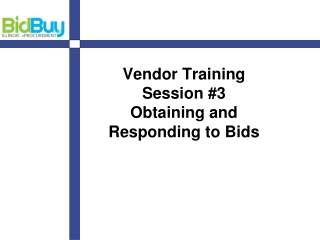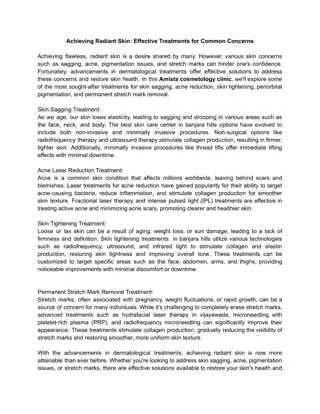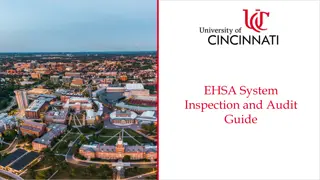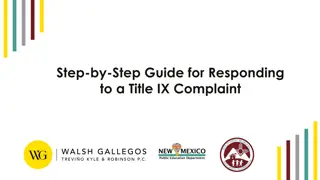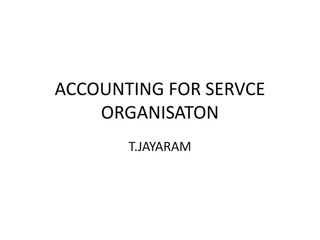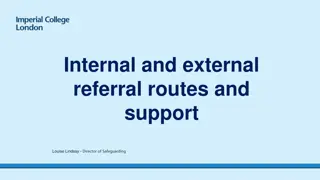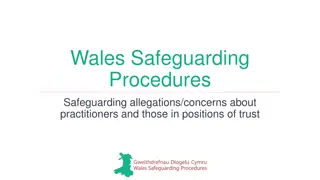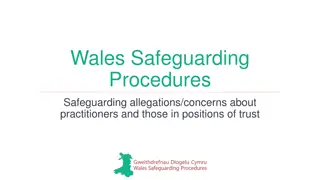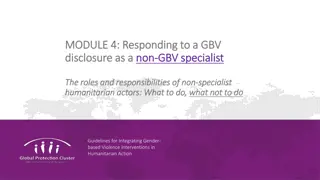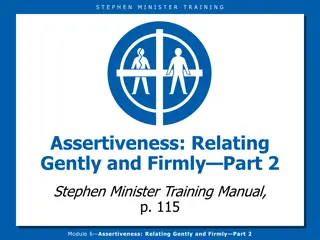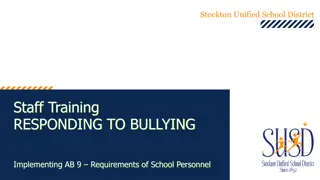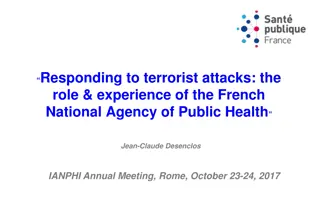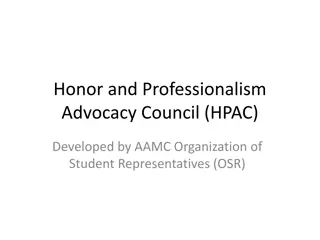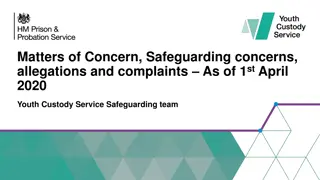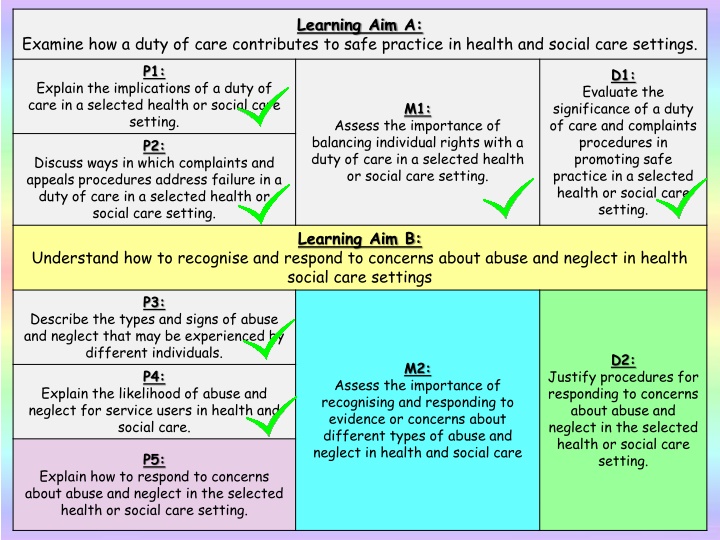
Duty of Care and Responding to Abuse in Health and Social Care
Explore the implications of duty of care, importance of recognizing abuse, and procedures for responding to concerns in health and social care settings. Learn about safeguarding measures and regulatory frameworks to ensure safe practices.
Download Presentation

Please find below an Image/Link to download the presentation.
The content on the website is provided AS IS for your information and personal use only. It may not be sold, licensed, or shared on other websites without obtaining consent from the author. If you encounter any issues during the download, it is possible that the publisher has removed the file from their server.
You are allowed to download the files provided on this website for personal or commercial use, subject to the condition that they are used lawfully. All files are the property of their respective owners.
The content on the website is provided AS IS for your information and personal use only. It may not be sold, licensed, or shared on other websites without obtaining consent from the author.
E N D
Presentation Transcript
Learning Aim A: Examine how a duty of care contributes to safe practice in health and social care settings. P1: Explain the implications of a duty of care in a selected health or social care setting. Assess the importance of balancing individual rights with a duty of care in a selected health or social care setting. appeals procedures address failure in a duty of care in a selected health or social care setting. Learning Aim B: Understand how to recognise and respond to concerns about abuse and neglect in health social care settings P3: Describe the types and signs of abuse and neglect that may be experienced by different individuals. P4: Explain the likelihood of abuse and neglect for service users in health and social care. D1: Evaluate the significance of a duty of care and complaints procedures in promoting safe practice in a selected health or social care setting. M1: P2: Discuss ways in which complaints and D2: M2: Justify procedures for responding to concerns about abuse and neglect in the selected health or social care setting. Assess the importance of recognising and responding to evidence or concerns about different types of abuse and neglect in health and social care P5: Explain how to respond to concerns about abuse and neglect in the selected health or social care setting.
Date: Friday, 21 March 2025 Lesson Title: Responding to concerns of suspected abuse or neglect. Lesson Outcome: Explain how to respond to concerns about abuse and neglect in the selected health or social care setting (P5)
Policies and procedures can vary in different types of institutions but all are covered by the Care Act (2014).
Organisation Checks and balances Potential action Many agencies work together to ensure that the most vulnerable in society are protected from potential abuse. Policies and procedures can vary depending on the type of institution but all are covered by the Care Act (2014). The ambulance service has developed a system for recognising cluster calls from people at risk of abuse or neglect. Neighbourhood Harm Register to raise an alert when there are repeat calls from individuals at risk of exploitation, neglect or abuse. This may include leading a multi-agency local adult safeguarding system in an enquiry. Should be represented on Safeguarding Adults Boards, and carry out safeguarding adults reviews where necessary. Advocates may also be provided by social services. Social services are regulated by the CQC to ensure that complaints of poor quality service are investigated. Social Services Staff in all front-line health and social care services should be trained in all identification of indicators of abuse. Health Services Data is shared with the appropriate agencies so they can work together to provide a joint response. Police It is an offence for those convicted of particular crimes to work with vulnerable people, and it is an offence for voluntary organisations to knowingly employ them, even in voluntary situations. The voluntary organisation must report barred applications who are trying to gain access to vulnerable individuals. A specific regulation on safeguarding people from abuse and improper treatment, which providers have to guarantee. CQC inspections to ensure the regulations is compiled with. Voluntary Organisations Disclosure and barring service (DBS) Care Quality Comission (CQC) Fundamental standards
Research Open the word document and complete the research to learn about different professional roles and legal responsibilities of those who respond to concerns of suspected abuse or neglect.
Task Why would CQC be unlikely to hear about problems at Winterbourne View from the service users? What issues could the CQC face if they are dealing with a culture of abuse and neglect ? How important is the documentation when pursuing a criminal investigation in a case of this kind, even if the records kept did not reflect what was going on? Why is it important to be a whistleblower, even if it means that you are at risk of losing your job? Winterbourne View was a residential unit designed for people with a range of learning difficulties. It was owned by a company called Castlebeck. In 2011, the BBC panorama programme sent an undercover reporter to investigate the quality of care there following reports that patients were being systematically abused and neglected by the staff. 1. 2. 3. The CQC had received various warnings that things at Winterbourne View were not right, but no action was taken. A senior nurse at Winterbourne View reported his concerns to the CQC but these were not followed up. So, eventually, the senior nurse alerted the BBC who sent their undercover reporter to investigate. 4.
Matthew Garnett, 15, has autism, learning difficulties and ADHD, as well as mental health issues that are yet to be properly assessed. His parents join Holly and Phillip to share the story of how he has spent the last six months stuck inside a psychiatric unit, which they say is keeping him like a prisoner . An example of other ways to whistleblow.
How can we reduce the likelihood of abuse and neglect? Identify people at risk and the importance of observation (be aware of patterns in behaviour, how the service user interacts with others. Awareness raising, providing information, advice and advocacy- (it s not uncommon for vulnerable people to be unaware of their risk to being abused. Inter-agency collaborations and multi-agency working Knowledge and understanding of legislation, regulation, policies and procedures. Staff training and continuing professional development. Promoting empowerment and choice for service users.
Winterbourne View was a hospital in South Gloucestershire for people with learning disabilities and autism whose behaviour sometimes made their families and professionals worry. It was meant to help by assessing and treating patients so that they could have ordinary lives in their own homes. Winterbourne View Hospital was owned by a company called Castlebeck. The NHS paid Castlebeck a lot of money to look after people there. It had 24 beds. In 2011, a TV programme showed some staff at Winterbourne View Hospital slapping and hurting patients and getting them on the floor. They sat on them and lay on them so the patients couldn t move. Sometimes they used chairs to stop them from getting up. Patients were bullied. They had water thrown at them. One woman was put in a shower wearing her clothes. Winterbourne View Hospital has now closed. You have been asked to write a report into how workers responded to the concerns of abuse and neglect. You will assess the importance of recognising and responding to evidence and concerns regarding abuse in this setting. You will justify procedures for responding to concerns.
P5: http://www.bbc.co.uk/news/uk-13700532 HOW Victims in the care home made complaints of they had allegedly been teased, forced to swallow medication How should staff have responded to the disclosures? How should they record and report their data? (Data Protection Act 1998). Workers complained to their manager who sent an email to Safeguarding Board- who are these people? Nurse whistleblows to the BBC. What is whistle blowing? M2: http://www.rcpsych.ac.uk/pdf/case%20review%20easy%20read.pdf WHY Why is it important to recognise and respond to the evidence/concerns? Reduce the likelihood of abuse and neglect from happening again- how can they do this? Which method would be the most important in a care home like Winterbourne View? What lessons can be learned? D2: http://www.bbc.co.uk/news/uk-england-bristol-20078999 how will this make changes for the future? Justify the procedures. The procedures made changes to how vulnerable adults are cared for in the UK. Whistleblowing seemed to have the biggest effect. Results of the serious case review included: Winterbourne view closed (no more abuse) Prosecution of abusers Council managers sacked fundamental changes are needed in how care of vulnerable adults is commissioned Government plans a reduction in the number of people with learning difficulties in these hospitals. http://www.bbc.co.uk/news/uk-20669741 https://www.gov.uk/government/uploads/system/uploads/attachment_data/file/2 13221/4-page-summary.pdf ATTIC-BANKS-GIRLS-APPLE-BRAIL-FROGS
D2: Recap the procedures for responding to concerns (immediate priorities and organisational procedures) Why would you use these? How would this have a beneficial impact on the victim? (Link to case studies where appropriate)


